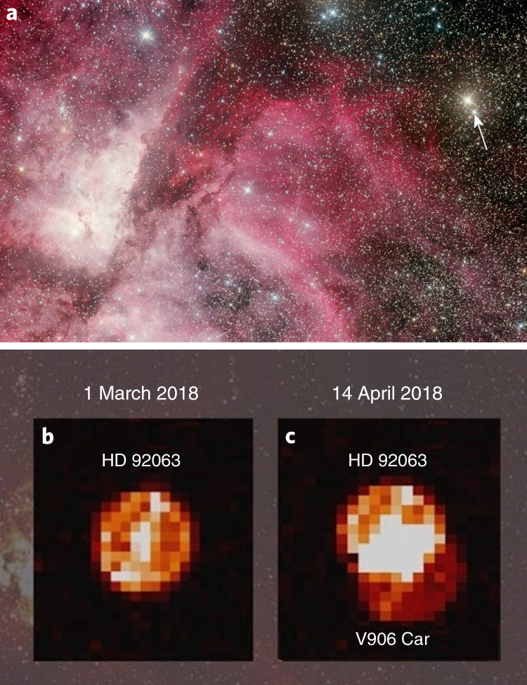Nature Astronomy ( IF 12.9 ) Pub Date : 2020-04-13 , DOI: 10.1038/s41550-020-1070-y Elias Aydi , Kirill V . Sokolovsky , Laura Chomiuk , Elad Steinberg , Kwan Lok Li , Indrek Vurm , Brian D. Metzger , Jay Strader , Koji Mukai , Ondřej Pejcha , Ken J. Shen , Gregg A. Wade , Rainer Kuschnig , Anthony F. J. Moffat , Herbert Pablo , Andrzej Pigulski , Adam Popowicz , Werner Weiss , Konstanze Zwintz , Luca Izzo , Karen R. Pollard , Gerald Handler , Stuart D. Ryder , Miroslav D. Filipović , Rami Z. E. Alsaberi , Perica Manojlović , Raimundo Lopes de Oliveira , Frederick M. Walter , Patrick J. Vallely , David A. H. Buckley , Michael J. I. Brown , Eamonn J. Harvey , Adam Kawash , Alexei Kniazev , Christopher S. Kochanek , Justin Linford , Joanna Mikolajewska , Paolo Molaro , Marina Orio , Kim L. Page , Benjamin J. Shappee , Jennifer L. Sokoloski

|
Classical novae are thermonuclear explosions that occur on the surfaces of white dwarf stars in interacting binary systems1. It has long been thought that the luminosity of classical novae is powered by continued nuclear burning on the surface of the white dwarf after the initial runaway2. However, recent observations of gigaelectronvolt γ-rays from classical novae have hinted that shocks internal to the nova ejecta may dominate the nova emission. Shocks have also been suggested to power the luminosity of events as diverse as stellar mergers3, supernovae4 and tidal disruption events5, but observational confirmation has been lacking. Here we report simultaneous space-based optical and γ-ray observations of the 2018 nova V906 Carinae (ASASSN-18fv), revealing a remarkable series of distinct correlated flares in both bands. The optical and γ-ray flares occur simultaneously, implying a common origin in shocks. During the flares, the nova luminosity doubles, implying that the bulk of the luminosity is shock powered. Furthermore, we detect concurrent but weak X-ray emission from deeply embedded shocks, confirming that the shock power does not appear in the X-ray band and supporting its emergence at longer wavelengths. Our data, spanning the spectrum from radio to γ-ray, provide direct evidence that shocks can power substantial luminosity in classical novae and other optical transients.
中文翻译:

新星中以冲击为动力的光发射的直接证据
经典的新星是热核爆炸,发生在相互作用的双星系统1中的白矮星的表面上。长期以来,人们一直认为经典新星的发光是由最初失控2之后,白矮星表面持续不断的核燃烧所推动的。但是,最近对经典新星产生的千兆电子γ射线的观察表明,新星弹出内部的冲击可能会主导新星的发射。还建议使用电击来增强各种事件的发光度,例如恒星合并3,超新星4以及潮汐破坏事件5。,但缺乏观测确认。在这里,我们报告了2018年新星V906船身(ASASSN-18fv)的同时天基光学和γ射线观测,揭示了两个波段中一系列显着的不同相关耀斑。光学耀斑和γ射线耀斑同时发生,这意味着发生电击是常见原因。在耀斑期间,新星的光度加倍,这意味着大部分光度是由冲击力驱动的。此外,我们检测到来自深埋的冲击的并发但微弱的X射线发射,确认了冲击功率未出现在X射线波段中,并支持了它在较长波长下的出现。我们的数据涵盖了从无线电到γ射线的光谱,提供了直接的证据,证明冲击可以增强经典新星和其他光学瞬变中的实质性光度。











































 京公网安备 11010802027423号
京公网安备 11010802027423号